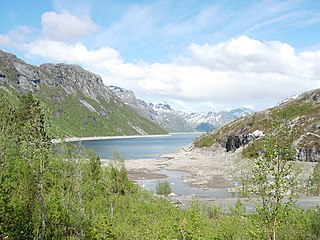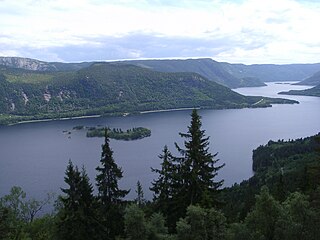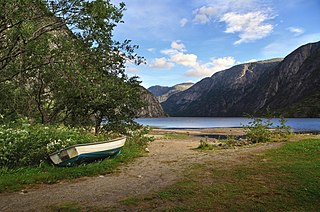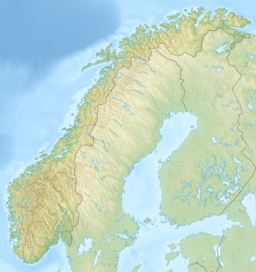
In physical geography, a fjord or fiord is a long, narrow inlet with steep sides or cliffs, created by a glacier. There are many fjords on the coasts of Alaska, Antarctica, British Columbia, Chile, Denmark, Germany, Greenland, the Faroe Islands, Iceland, Ireland, Kamchatka, the Kerguelen Islands, Labrador, Newfoundland, New Zealand, Norway, Novaya Zemlya, Nunavut, Quebec, Russia, South Georgia Island, Tasmania, United Kingdom, and Washington state. Norway's coastline is estimated to be 29,000 km (18,000 mi) long with its nearly 1,200 fjords, but only 2,500 km (1,600 mi) long excluding the fjords.

Mjøsa is Norway's largest lake, as well as one of the deepest lakes in Norway and in Europe. It is the fourth-deepest lake in Norway. It is located in the southern part of Norway, about 100 kilometres (62 mi) north of the city of Oslo. Its main tributary is the river Gudbrandsdalslågen flowing in from the north; the only distributary is the river Vorma in the south. Inflows would theoretically need 5.6 years to fill the lake. With an average depth of about 153 metres (502 ft), most of the lake's volume is under sea level. The average outflow of the lake (measured from 1931–1982) is 316 cubic metres per second (11,200 cu ft/s) which is about 9,959,000,000 cubic metres per year (1.1145×1010 cu ft/Ms). Mjøsa contains about 56 cubic kilometres (45,000,000 acre⋅ft) of water compared to the 15 cubic kilometres (12,000,000 acre⋅ft) in the lake Røssvatnet, the second largest lake by volume in Norway.

Femunden is Norway's third largest lake and the second largest natural lake in Norway. It is located in Innlandet and Trøndelag counties in Norway, just 13 kilometres (8.1 mi) west of the border with Sweden. The lake lies primarily in the municipality of Engerdal and also smaller parts are located in the municipalities of Os (Innlandet) and Røros (Trøndelag). Femundsmarka National Park borders the northeastern part of the lake.

Hornindalsvatnet is Norway's and Europe's deepest lake, and the world's twelfth deepest lake, officially measured to a depth of 514 metres (1,686 ft). Its surface is 53 metres (174 ft) above sea level, which means that its bottom is 461 metres (1,512 ft) below sea level.

Snåsavatnet is Norway's sixth-largest lake. The 122-square-kilometre (47 sq mi) lake is located in the municipalities of Steinkjer and Snåsa in Trøndelag county, Norway. The villages of Følling and Sunnan lie at the southwestern end of the lake and the village of Snåsa lies at the northeastern end of the lake. European route E6 runs along the northern shore of the lake and the Nordland Line runs along the southern shore.
Båvrojávrre is a lake that lies on the border between Norway and Sweden. Most of the 6.08-square-kilometre (2.35 sq mi) lake lies in Norway in Narvik Municipality in Nordland county. Only 0.61 square kilometres (0.24 sq mi) of the lake lies in Sweden in Gällivare Municipality in Norrbotten County. The lake Baugevatnet lies just to the north. The ending -jávrre is the Lule Sami word for lake.
Fiskelausvatnet (Norwegian) or Guelehtsjaevrie (Southern Sami) is a lake that lies in the municipality of Grane in Nordland county, Norway. The lake lies in the northern part of Grane, about 13 kilometres (8.1 mi) northeast of Trofors. The name of the lake translates as "fishless lake".
Gautelisvatnet (Norwegian) or Guovdelisjávri (Northern Sami) is a lake that is located on the border of Norway and Sweden, about 50 kilometres (31 mi) southeast of the town of Narvik. The Norwegian side lies in Narvik Municipality in Nordland county and the Swedish side lies in Gällivare Municipality in Norrbotten County. The 17.67-square-kilometre (6.82 sq mi) lake has a dam on the northern end and the water is used for hydropower. After the dam was built, the lake grew and merged with the lake Vannaksvatnet to the south. The lake Unna Guovdelisjávri lies just to the east of this lake.

Heggmovatnet is a lake that lies in the municipality of Bodø in Nordland county, Norway. The 9.38-square-kilometre (3.62 sq mi) lake is located about 10 kilometres (6.2 mi) northeast of the village of Løding. The lake is regulated and it is the main water source for the town of Bodø. The water flows out of the lake into the river Heggmoelva, which then flows into the lake Vatnvatnet. Sjunkhatten National Park surrounds the lake.
Sandnesvatnet (Norwegian) or Sáttonjárgjávrre (Lule Sami) is a lake in the municipality of Hamarøy in Nordland county, Norway. The European route E6 highway runs along the eastern and northern shores of the lake. The lake lies about 5 kilometres (3.1 mi) southeast of the village of Tømmerneset. The lake Strindvatnet lies just to the northwest and the lake Fjerdvatnet lies to the south of the lake.
Sefrivatnet (Norwegian) or Sohkerde (Southern Sami) is a lake that lies in the municipality of Grane in Nordland county, Norway. The 2.36-square-kilometre (0.91 sq mi) lake lies between the lakes Majavatnet and Storsvenningvatnet. European route E6 and the Nordland Line both run along the eastern edge of the lake.

Gjende or Gjendin is a lake in Vågå Municipality in Innlandet county, Norway. It is located in the Jotunheimen mountain range and also inside Jotunheimen National Park. The proglacial lake shows typical characteristics of glacial formation, being long and narrow, with steep walls. The lake is 18 kilometres (11 mi) in length and only 1.5 kilometres (0.93 mi) in width at the broadest point. Gjende has a characteristic light-green color resulting from the large quantity of rock flour which is discharged into the Gjende by the Muru river. The river Sjoa provides the outlet from Gjende at Gjendesheim, and flows eastward into the Gudbrandsdalslågen river.

Rosskreppfjorden is a lake in Norway. The 29.51-square-kilometre (11.39 sq mi) lake lies on the border between the municipalities of Valle and Sirdal in Agder county. The lake is part of the Kvina river system and has a hydroelectric power plant in a dam on the south end of the lake. The dam keeps the lake at an elevation of about 929 to 890 metres above sea level.
Kilefjorden is a lake on in Agder county, Norway. The lake is located on the border of the municipalities of Evje og Hornnes, Iveland, and Vennesla. The lake is part of the river Otra. The lake is located about 6 kilometres (3.7 mi) west of the village of Birketveit in Iveland, about 2.5 kilometres (1.6 mi) north of the village of Hægeland in Vennesla, and about 15 kilometres (9.3 mi) south of the village of Hornnes in Evje og Hornnes.
Botsvatn or Bossvatn is a lake in the municipality of Bykle in Agder county, Norway. The 14.6-kilometre (9.1 mi) long, narrow reservoir is located just to the southeast of the large lake Blåsjø and northeast of the lake Ytre Storevatnet. The lake holds water for the Brokke Hydroelectric Power Station, located in nearby Valle municipality. The water from the lake can flow out into the nearby river Otra, but only when water is released from the dam.

Byglandsfjorden is a lake in Agder county, Norway. The 32.79-square-kilometre (12.66 sq mi) lake lies on the river Otra, primarily in the municipality of Bygland, but the far southern tip of the lake extends into the neighboring municipality of Evje og Hornnes. The river flows out of the lake Åraksfjorden to the north and into the Byglandsfjorden through a narrow channel, and the southern end of the Byglandsfjorden is marked by a dam along the river. The villages of Byglandsfjord, Grendi, Longerak, Lauvdal, and Bygland are all located on the eastern shore of the lake along the Norwegian National Road 9. The western shore of the lake is much more sparsely populated, with County Road 304 following that shoreline.

Eidfjordvatnet is a moraine-dammed lake in the municipality of Eidfjord in Vestland county, Norway. The 3.55-square-kilometre (1.37 sq mi) lake is located immediately southeast of the village of Eidfjord. The village of Øvre Eidfjord lies on the southern shore of the lake. Norwegian National Road 7 runs along the western shore of the lake. The water enters the lake through the Bjoreio and Veig rivers, and the water empties from the lake through the Eio River.

Jølstravatnet or Jølstravatn is a lake in Sunnfjord Municipality in Vestland county, Norway. The lake empties its water into the 20-kilometre (12 mi) long Jølstra river which then flows into the Førdefjorden. The impressive eastern arm of Jølstravatn is called Kjøsnesfjorden, although it is not a true fjord that is part of the sea. The villages of Skei, Helgheim, Ålhus, and Vassenden are located on the shores of the lake.
Överuman or Uman is a lake on the border between Norway and Sweden. Most of the 52.49-square-kilometre (20.27 sq mi) lake is located in Storuman Municipality in Västerbotten County in Sweden. A small 3.17-square-kilometre (1.22 sq mi) part of the lake, known as Umbukta, is located in Rana Municipality in Nordland County in Norway. The European route E12 highway runs along the eastern side of the lake. The lake lies just southeast of the large lake Storakersvatnet.

Bogstadvannet is a lake between the city of Oslo and the municipality of Bærum, Akershus, Norway. It is part of Sørkedalsvassdraget, which in turn is part of Oslomarkvassdraget.













